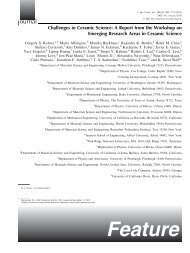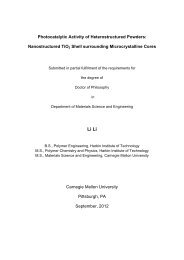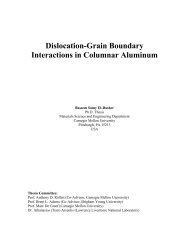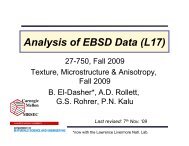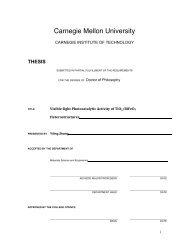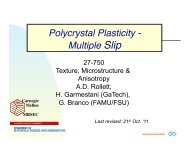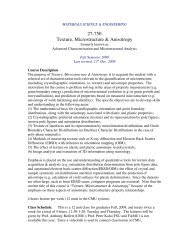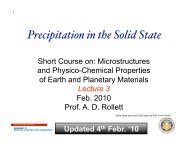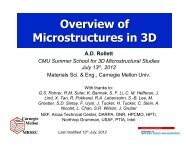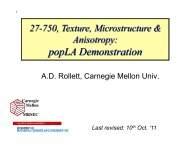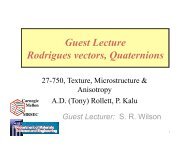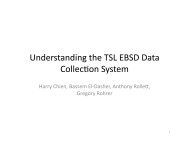¶ 3. Mathematical Representation of Crystal Orientation, Misorientation
¶ 3. Mathematical Representation of Crystal Orientation, Misorientation
¶ 3. Mathematical Representation of Crystal Orientation, Misorientation
Create successful ePaper yourself
Turn your PDF publications into a flip-book with our unique Google optimized e-Paper software.
The resulting rotation can be converted to a matrix (passive rotation) by the following<br />
expression, where δ is the Kronecker delta and ε is the permutation tensor.<br />
a ij = δ ij cosθ + r i r j 1− cosθ<br />
( ) + ε ijk r k sinθ<br />
k =1,3<br />
Note that the active rotation is obtained by changing the sign <strong>of</strong> the third term on the<br />
RHS in order to obtain the transpose. The axis-angle pair can be recovered from a matrix<br />
by finding the eigenvector associated with the only real eigenvalue <strong>of</strong> the matrix, and<br />
examination <strong>of</strong> the trace <strong>of</strong> the matrix. The quantity norm is equal to 2sinθ. Note that<br />
from a numerical perspective, the cosine formula for the angle is more accurate at large<br />
angles, whereas the sine formula is more accurate for small rotation angles. Also, when<br />
working with the inverse cosine function in computer programs, it is good practice to<br />
check the magnitude <strong>of</strong> the argument and force it to lie between -1 and +1.<br />
<strong>3.</strong>E Rodrigues vectors<br />
norm = [ a(2,3) − a(3,2) ] 2 + [ a(1,3) − a(3,1) ] 2 + [ a(1,2) − a(2,1) ] 2<br />
( r1 ,r2 ,r3 ) = ( a(2,3) − a(3,2),a(1,3) − a(3,1),a(1,2) − a(2,1) )/ norm<br />
θ = cos −1 tr[ a]<br />
−1<br />
2<br />
Another choice in more general use than Euler angles is that <strong>of</strong> Rodrigues vectors,<br />
as popularized by Frank [Frank, F. (1988). “<strong>Orientation</strong> mapping.” Metallurgical<br />
Transactions 19A: 403-408.], hence the term Rodrigues-Frank space for the set <strong>of</strong><br />
vectors. It has turned out to be quite useful for representation <strong>of</strong> misorientations for the<br />
reason that many <strong>of</strong> the boundary types that correspond to a high fraction <strong>of</strong> coincident<br />
lattice sites (i.e. low sigma values in the CSL model) occur on the edges <strong>of</strong> the Rodrigues<br />
space and their coefficients are reciprocals <strong>of</strong> integer values. Some authors [Neumann, P.<br />
(1991). “<strong>Representation</strong> <strong>of</strong> orientations <strong>of</strong> symmetrical objects by Rodrigues vectors”,<br />
Textures and Microstructures 14-18 53-58] have pointed out that it has advantages for<br />
texture representation also. Any set <strong>of</strong> points related by a common axis lie on a straight<br />
line in Rodrigues space, for example, which has advantages for numerical manipulation<br />
<strong>of</strong> orientation data. As a consequence <strong>of</strong> its use in misorientation representation, the<br />
rotation matrix is denoted by ∆a, where the ∆ denotes a difference in orientation, i.e.<br />
misorientation.<br />
This representation can be thought <strong>of</strong> as an axis-angle representation in which the<br />
direction <strong>of</strong> the R-F vector is parallel to the rotation axis and the magnitude <strong>of</strong> the vector<br />
is the tangent † <strong>of</strong> the semi-angle (θ/2). The convenient features <strong>of</strong> R-F space include the<br />
† Note that this scaling <strong>of</strong> the vector corresponds to the stereographic projection used in pole<br />
figure representation.<br />
∑<br />
8/27/09 14



